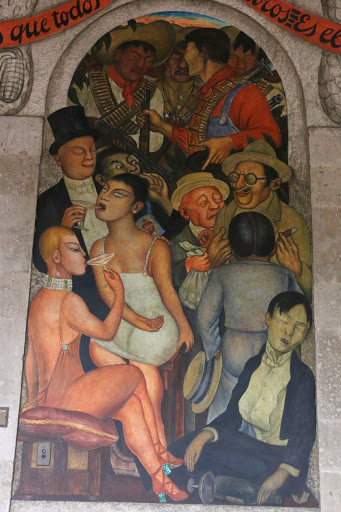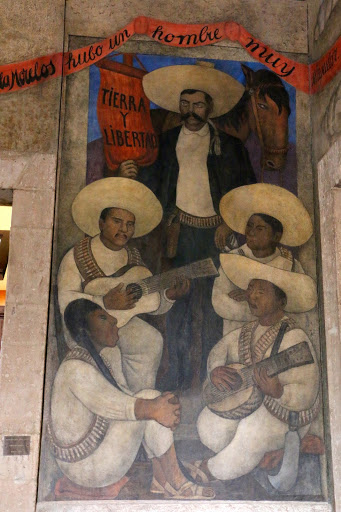Just around the corner and down the street from the Secretariat of Public Education is another building central to the history of both education and art in Mexico. The Jesuit College (School) of San Ildefonso was founded in 1583 by combining three other Catholic colleges or schools.
During the early decades of the eighteenth century the building was renovated, resulting in the edifice that stands today as one of the most outstanding examples of Spanish Baroque architecture in Mexico City.
 |
| Antiguo Colegio de San Ildefonso on Calle Justo Sierra Centro Historico |
After the Jesuits were expelled by decree of King Carlos III in 1767, the building was "repurposed", as we moderns would say, as headquarters of a battalion of the Regiment of Flanders, a school administered by the colonial government, temporary headquarters for the School of Jurisprudence and some departments of the School of Medicine.
In 1847, at the end of the Mexican American War, the building served as the headquarters for the occupying U.S. Army and, from 1863 to 1867, it fulfilled the same purpose for French troops during the French Intervention.
 |
| Central Patio Murals by Jose Clemente Orozco visible in right hand portal Photo: Rebecca Brundage Clarkin |
In 1867, the government of Benito Juárez launched an education reform replacing the schools controlled by the Catholic Church with secular, public education. As part of the Organic Law of Education, the National Preparatory (High) School was created and lodged in the former College of San Ildefonso. In 1910, just before the outbreak of the Mexican Revolution, the School became part of the National University (UNAM) founded by Justo Sierra. The School continued to occupy the building until it was moved to new quarters in 1978.
The building remained closed until 1992, when it was restored to house the exhibition 'Mexico, Splendors of 30 Centuries' to mark the 500th anniversary of the arrival of Columbus. Since then, the Antiguo Colegio de San Ildefonso has functioned as a museum managed by a team from the National Autonomous University of Mexico, the National Council for Culture and Arts and Mexico City. It hosts temporary exhibits, often of international art. An exhibit of Islamic Art was the most recent.
The Mexican Revolution, José Vasconcelos, Diego Rivera and José Clemente Orozco
After the Mexican Revolution, in 1920, José Vasconcelos was appointed head of the National University, which included overseeing the National Preparatory School. A year later, President Álvaro Obregón appointed him head of the new Secretariat of Public Education, which was intended to fulfill Benito Juárez's vision of secular education for all.
As part of his project to create representations of a post-Revolutionary Mexican identity, Vasconcelos decided to have murals painted in the National Preparatory School, as well as in the new Secretariat of Education, two blocks away. The first mural in the Preparatory School was created in 1922 by Diego Rivera, who had just returned from Europe at Vasconcelos's request to undertake his mural project.
| La Creación The Creation |
The Creation is Rivera's tour de force attempt to realize Vasconcelos' vision: the synthesis of Classical European and indigenous Mexican cultures. His materials and techniques reflect his intent—creating his paints, for example, by using copal, a native Mexican pine resin, and beeswax mixed with local pigments. The esthetic style is reminiscent of European medieval paintings, with its static figures, including groups with halos in the background, and angel-like figures suspended on wing-like clouds.
A nude couple, the Adam and Eve of the new mestizaje, mixed race, culture envisioned by Vasconcelos, sit, observing at each side. At the right, the new Adam gazes at female figures representing indigenous culture: legends, practical knowledge, poetry, tradition and, curiously, tragedy, represented by a person holding a classic Greek theater mask. Behind and above are representations of the Classic virtues of Prudence, Justice, Strength and Self-restraint.
At the left are the Performing Arts: music, represented by a Greek Panpipe, song, dance and comedy. Behind are the Biblical virtues of Charity (Love), Hope and Faith. The angels represent wisdom and science. All of the figures are portraits of contemporary Mexican women, many performing artists or favorite painters' models.
Within the central arch rises the New Man, offspring of this New Creation. We have already seen a later version of this same figure in Rivera's 1934 mural El Hombre En El Cruce de Caminos (Man at the Crossroads) in Bellas Artes.
Above all these ancient and new-born creatures shines a medieval-style representation of the blue firmament of the heavens, divided into the four cardinal directions that are archetypical in all primary cultures. We will see this intense azure sky again here in San Ildefonso.
Recalling the murals in Porfirio Díaz's Palace of Communications, we think the old promoter of Order and Progress might be quite pleased with the Classic foundation and optimistic content of Rivera's work, if not with its revolutionary message. He might even have been pleased with its Art Nouveau style.
In fact, there is a Porfirian context for this continuity right here in the Preparatory School:
José Clemente Orozco Comes to San IldefonsoWithin the central arch rises the New Man, offspring of this New Creation. We have already seen a later version of this same figure in Rivera's 1934 mural El Hombre En El Cruce de Caminos (Man at the Crossroads) in Bellas Artes.
Above all these ancient and new-born creatures shines a medieval-style representation of the blue firmament of the heavens, divided into the four cardinal directions that are archetypical in all primary cultures. We will see this intense azure sky again here in San Ildefonso.
Recalling the murals in Porfirio Díaz's Palace of Communications, we think the old promoter of Order and Progress might be quite pleased with the Classic foundation and optimistic content of Rivera's work, if not with its revolutionary message. He might even have been pleased with its Art Nouveau style.
 |
| Progress Bestows Her Blessings, Ceiling mural in the Reception Hall Palace of Communications now National Museum of Art |
In fact, there is a Porfirian context for this continuity right here in the Preparatory School:
 |
| "Order and Progress" Porfirian motto from the late 19th century over a doorway at the Preparatory School |
 |
| Bienvenida (Latin: Salve) Welcome 1899 Stained glass window at top of stairs |
Vasconcelos then put Rivera to work creating murals in the Secretariat of Education, so he hired the artist José Clemente Orozco (1883-1949) to add more murals at the Preparatory School. Orozco was forty years old. He was to bring a very different style of painting and a very different view of the Mexican Revolution to the walls of the School.
See more on the Mexican Revolution and Mexican Muralists
Part I: Bellas Artes
Part II: The Academy of San Carlos and Dr. Atl
Part III: Secretariat of Education, José Vasconcelos and Diego Rivera
Part IV: Secretariat of Education and Diego Rivera's Vision of Mexican Traditions
Part V: Secretariat of Education and Diego Rivera's Ballad of the Revolution
Part VII: José Clemente Orozco Comes to San Ildefonso
Part VIII: College of San Ildefonso and José Clemente Orozco - Continued
Part IX: David Siqueiros, Painter and Revolutionary
Part X: David Siqueiros Cultural Polyforum
Part XI: The Abelardo Rodríguez MarketFor background on the Mexican Revolution, see:
Mexican Revolution: Its Protagonists and Antagonists




















